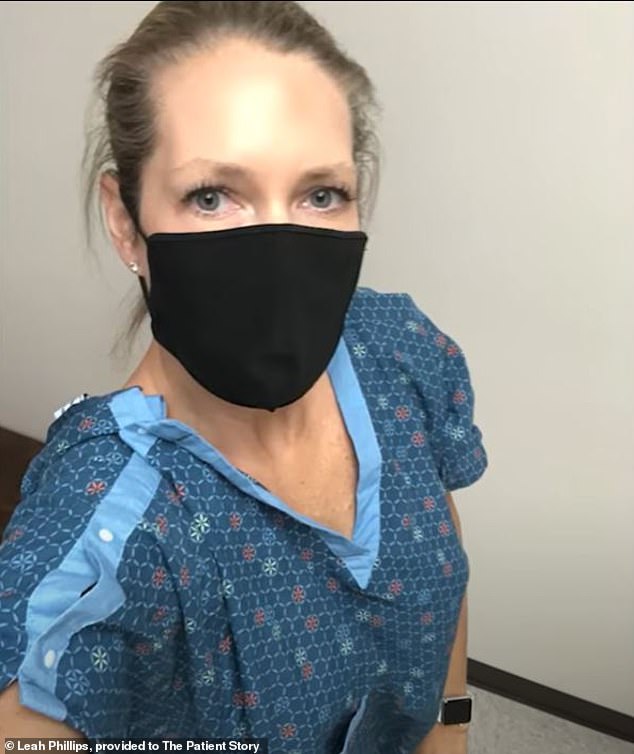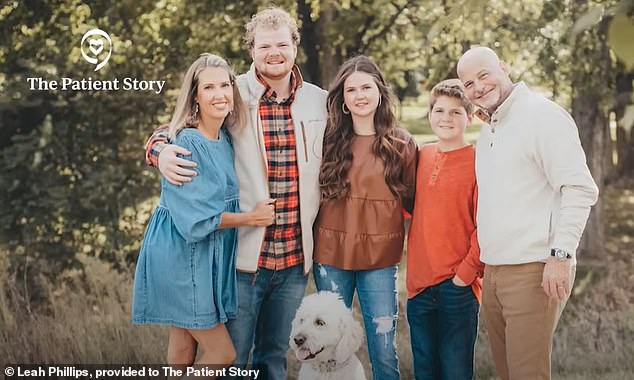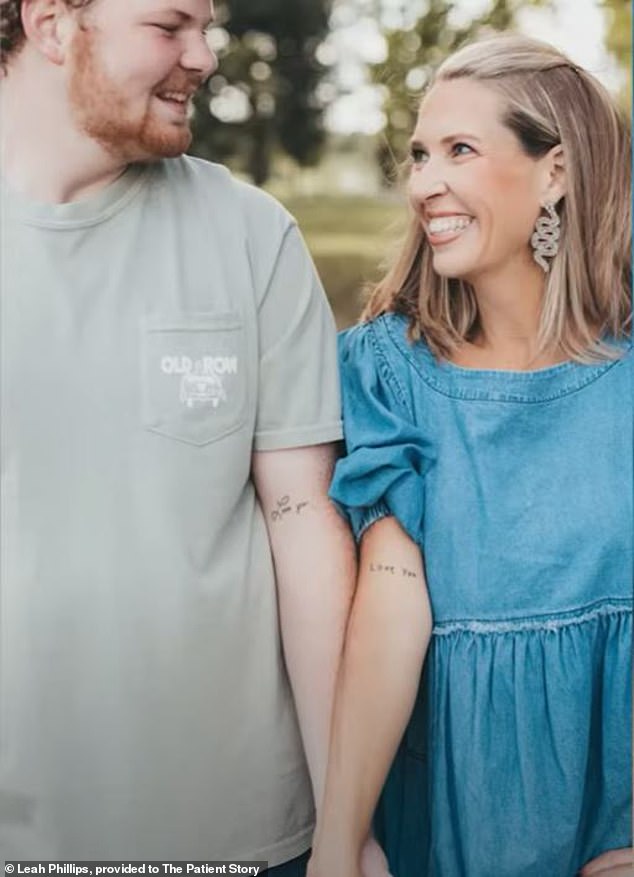I’ve never touched a cigarette, so why was I diagnosed with “death sentence” lung cancer at age 43?
A Kentucky woman was diagnosed with stage four lung cancer and told she had only six months to live, despite the fact that she had never smoked and was physically active.
Leah Phillips was just 43 years old in September 2019 when she developed a dry, nagging cough. Two weeks later, doctors dismissed it as the remnants of a generic virus she had contracted.
A few days of steroids relieved the cough, although it returned a few weeks later, along with shortness of breath. Mrs Phillips, a long-distance runner, now found it difficult to keep up with her running group and suffered from a ‘heaviness’ in her chest.
After returning to the doctor and pushing for more tests, scans revealed consolidation in her right lung, which happens when air in the airways is replaced by fluid, blood or other materials. It can be a sign of multiple health complications, and the mother of three was diagnosed with pneumonia.
Leah Phillips (above right with her husband and children) was diagnosed with stage four non-small cell lung cancer at age 43, despite never having smoked

“My mother, my husband and I were completely devastated because none of us knew you could get lung cancer without smoking,” Ms Phillips told The Patient Story.
She was prescribed antibiotics, but halfway through the treatment she started coughing up blood. Doctors gave her stronger antibiotics and later admitted her to the hospital for four days for further tests and observation.
The medical team insisted that Mrs Phillips simply had persistent pneumonia, despite the fact that she was losing weight, coughing, could barely climb stairs and had pain in her right shoulder and right rib.
“I looked terrible,” said Mrs. Phillips, now 47, The patient’s story.
‘I was standing in the doctor’s waiting room crying to the ladies in the front, saying, “There’s something seriously wrong with me. I need someone to see me. I need someone to listen to me.”
“I said, ‘I’m not leaving here until someone sees me.’”
A few months later, in December 2019, CT scans and bone biopsies revealed it was stage four non-small cell lung cancer.
She said: ‘My husband, mother and I were completely devastated because none of us knew you could get lung cancer without smoking.
“That oncologist told me I only had six to 12 months to live and that I needed to get my affairs in order. I was 43 and had small children.
‘I remember sitting there and bursting into tears. I thought, “This can’t be happening. You’re dying of metastatic cancer, and I’m alive now.”‘
According to the National Cancer Institute (NCI), lung cancer is the deadliest form of cancer in the U.S. It accounts for one in five cancer deaths, and just over half of cases are diagnosed after the disease has spread to other organs.
Mrs Phillips’ cancer had spread to her spine and pelvis.
Only one in four lung cancer patients survives after five years.
Non-small cell lung cancer is the most common type, accounting for nine out of 10 lung cancer diagnoses. It tends to grow more slowly than small cell lung cancer and usually does not cause symptoms until it is advanced.

The mother of three (left), seen here with her family, was physically active and part of a running club when she was diagnosed with lung cancer

Mrs Phillips, pictured with her son, is in stable condition, although she will ‘never be in remission’ due to the aggressive nature of the cancer.
Ms. Phillips is among a growing group of people diagnosed with early-onset cancer, a diagnosis made before the age of 50.
One in 10 lung cancer diagnoses in the U.S. occurs in patients under age 55, but experts warn that the number of early cases has increased over the past two decades.
Although smoking is still the leading cause of lung cancer, the number of young patients who have never smoked is also increasing.
Genetic testing revealed that Ms. Phillips had a mutation in her EGFR gene, a mutation most common in female, non-smoking lung cancer patients.
About 10 to 15 percent of the 234,000 patients diagnosed with lung cancer each year have an EGFR mutation.
She also wrote for Project Environmental that her doctor believes radon exposure increases her risk of cancer.
Radon, a known carcinogen, is an invisible, odorless gas produced by the radioactive decay of uranium in rocks, soil, and water. The World Health Organization estimates that radon is responsible for three to fourteen percent of lung cancers.
She believes she is more exposed to radon because she lives in Kentucky, where the chemical is common.
Dr. Laura Mezquita, a medical oncologist in Spain, said at an oncology conference earlier this summer: ‘Radon is the leading cause of cancer in non-smokers. Radon is also a risk factor in young populations.’
She said this could be due to exposure to radon from birth, which can happen when radon enters a home through contaminated soil. And a 2019 report in Nature finds that exposure to radon in homes is increasing as modern construction becomes more airtight and traps chemicals.
Ms. Phillips was quickly started on the oral chemotherapy drug osimertinib, which is used specifically to treat non-small cell lung cancer in patients with genetic mutations.
After a year of treatment, the main tumor in her right lung had shrunk by 70 percent and the disease in her bones had diminished.
In November 2020, she began eight intensive radiation sessions to target the remaining cancer.
The cancer has been stable since then, although the chemotherapy drug is estimated to only keep the cancer under control for two to three years, after which it can grow and spread again.
Although Ms. Phillips has been stable on the drug for four and a half years, her doctors believe the drug will work. And even if it continues to work, her tumors will not shrink any more.
“It’s not a question of if I’ll move forward, it’s a question of when,” she said. “I’m on, I guess, borrowed time. There’s no official next step.
“I will never be in remission. I will never be cured.”
Although the outlook for Ms Phillips is bleak, she urges other young people to stand up for themselves with doctors and not take ‘no’ for an answer.
She said, ‘What if I wasn’t educated? What if I didn’t stand up for myself? What if I didn’t have the financial resources or the insurance to keep going back. That’s what breaks my heart.
‘Getting fired has never been my style. I’m not one for confrontation, but when I’m passionate about something… I stand up for what I believe in, and I knew I deserved better care than what I was getting.
“You have to stand up for yourself and if you feel like you can’t, you have to find someone who can.”
